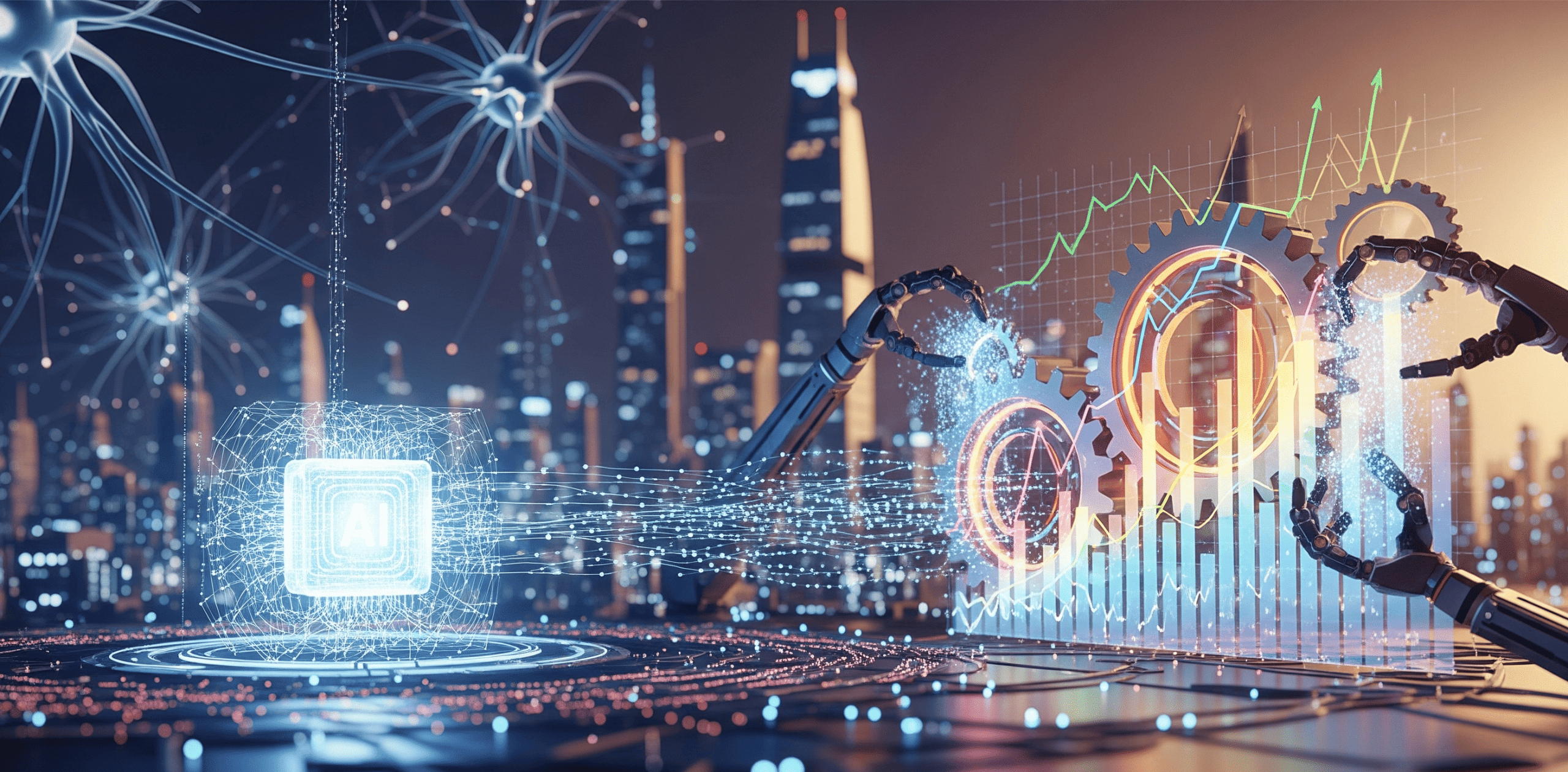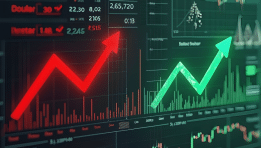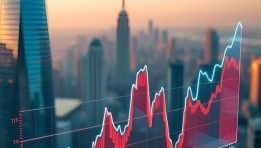A newly published chart from the U.S. Bureau of Economic Analysis (BEA) reveals a striking shift in the dynamics of economic growth: in late 2024 and early 2025, investments in information processing equipment and software surged, contributing more than 0.75% to real GDP growth—after hovering near zero for several quarters. Meanwhile, personal consumption expenditures (PCE), traditionally the backbone of U.S. growth, saw a significant drop from their 2023 highs.
This divergence marks more than a cyclical fluctuation. It signals the potential emergence of a new economic structure—one in which technology investment is not just a support tool but a standalone engine of growth.
When Investments Outpace the Consumer
The light blue line in the chart represents the contribution of personal consumption (PCE) to GDP growth, while the dark blue line shows the contribution from investments in information processing equipment and software. From 2022 through most of 2024, consumption dominated. But beginning in mid-2024, the technology investment line started climbing sharply—surpassing 0.75%—while consumption weakened.
Historically, U.S. economic growth has been consumer-driven: household spending, services, and housing fueled expansions. But the data now tells a different story—corporations are stepping into the driver’s seat, aggressively investing in digital infrastructure, data centers, software stacks, and AI systems. This shift likely reflects an urgent race to establish competitive advantages in the emerging artificial intelligence economy.
AI Is No Longer a Vision — It’s a Growth Driver
The sharp rise in tech-related investment appears to be driven by a massive push into AI infrastructure: advanced servers, GPU clusters, machine learning platforms, and cloud architecture. What was once a dormant sector in terms of GDP contribution is now reawakening, powering real, measurable growth.
Big Tech may be leading the charge, but traditional sectors—banking, manufacturing, logistics, and healthcare—are not far behind. These firms are integrating AI to optimize workflows, forecast demand, automate decisions, and extract operational efficiencies. As a result, demand for data processing equipment, software, and storage solutions is expanding across the board.
This is not a passing trend—it’s a transformational shift in how the economy operates at its core.
Is AI Replacing the Consumer as the Growth Engine?
From 2022 to 2023, personal consumption contributed between 1.5% and 2.5% to real GDP growth—a reliable driver. But by the end of 2024, its contribution plummeted. Meanwhile, the tech investment component, once negligible, accelerated.
This trend highlights the structural divergence between households and corporations. High inflation, rising interest rates, and real wage stagnation constrain consumer spending. But companies flush with capital are deploying that liquidity into AI investments—seeing them as existential, not optional.
The implication is profound: we may be entering an era where growth is less dependent on domestic demand and more on technological deployment and global competitiveness.
What This Means for Investors and Policymakers
For investors, this is a clear signal to recalibrate portfolio strategies. Companies that manufacture semiconductors (like Nvidia), provide cloud infrastructure, or develop AI platforms are becoming central pillars of economic momentum. These sectors are evolving from “growth stocks” into the equivalent of industrial utilities for the digital era.
From a policy perspective, the shift complicates traditional interpretations of GDP dynamics. Growth driven by investment—not consumption—may not spark inflation in the same way, potentially altering the Federal Reserve’s calculus on interest rates and monetary tightening.
Moreover, governments may need to reorient incentives—prioritizing technological infrastructure, AI education, and public-private innovation frameworks—to ensure long-term competitiveness.
Not a One-Off — But a Structural Break
This surge is not just statistically significant; it’s economically historic. For most of the past decade, tech-related investments contributed less than 0.3% to GDP growth—and sometimes even dragged it down. Now that the figure exceeds 0.75%, we’re witnessing a structural break.
This is a clear pivot from a consumption-led to an investment-led economy, driven by digital capabilities. The U.S. isn’t just consuming innovation—it’s funding and scaling it as a national growth engine.
If the trend continues, the broader policy narrative could shift toward national AI infrastructure, cloud capacity development, and sovereign technology strategies.
Bottom Line
The chart depicts a new reality: artificial intelligence is no longer just a tech trend—it’s a macroeconomic force. As consumer spending fades as a primary engine of growth, investment in digital infrastructure is stepping up to fill the gap.
For analysts, investors, and decision-makers alike, this is not a future scenario. It’s the present.
The GDP of tomorrow is already being built today—through servers, software, and AI.
Comparison, examination, and analysis between investment houses
Leave your details, and an expert from our team will get back to you as soon as possible
* This article, in whole or in part, does not contain any promise of investment returns, nor does it constitute professional advice to make investments in any particular field.
To read more about the full disclaimer, click here- orshu
- •
- 7 Min Read
- •
- ago 4 hours
 THE AMERICAS MARKET CLOSES IN THE RED, DRIVEN BY BROADER SELL-OFF
THE AMERICAS MARKET CLOSES IN THE RED, DRIVEN BY BROADER SELL-OFF
The final trading session of the week for the Americas' markets saw a broad decline, as a wave of selling
- ago 4 hours
- •
- 7 Min Read
The final trading session of the week for the Americas' markets saw a broad decline, as a wave of selling
- orshu
- •
- 6 Min Read
- •
- ago 6 hours
 U.S. Labor Market Weakens Sharply: Job Growth Disappoints, Prior Data Revised Down Heavily
U.S. Labor Market Weakens Sharply: Job Growth Disappoints, Prior Data Revised Down Heavily
The latest U.S. jobs report paints a troubling picture of the labor market's momentum. The economy added just 73,000 jobs in
- ago 6 hours
- •
- 6 Min Read
The latest U.S. jobs report paints a troubling picture of the labor market's momentum. The economy added just 73,000 jobs in
- orshu
- •
- 7 Min Read
- •
- ago 7 hours
 USA Rare Earth (USAR): A Strategic Bet on America’s Critical Mineral Independence
USA Rare Earth (USAR): A Strategic Bet on America’s Critical Mineral Independence
Initiation with a $16 Price Target — What's the Rationale? Cantor Fitzgerald has initiated coverage on USA Rare Earth (Ticker: USAR) with
- ago 7 hours
- •
- 7 Min Read
Initiation with a $16 Price Target — What's the Rationale? Cantor Fitzgerald has initiated coverage on USA Rare Earth (Ticker: USAR) with
- orshu
- •
- 6 Min Read
- •
- ago 7 hours
 ExxonMobil Q2 2025 Earnings: Operational Strength Amid Net Income Decline
ExxonMobil Q2 2025 Earnings: Operational Strength Amid Net Income Decline
ExxonMobil (NYSE: XOM) released its Q2 2025 earnings report, highlighting robust operational metrics and continued cost efficiencies, despite a notable
- ago 7 hours
- •
- 6 Min Read
ExxonMobil (NYSE: XOM) released its Q2 2025 earnings report, highlighting robust operational metrics and continued cost efficiencies, despite a notable












